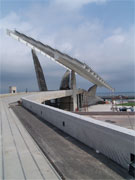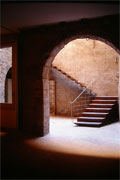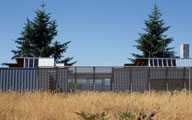

 |
 |
 |
 |
 |
 |
 |
 |
 |
 |
LECTURES 2004–05 |
||||
|
SITEGEIST: Nature, Memory, Identity Ideas about site, landscape, and place, emanating from critical writing and practice in landscape architecture, architecture, and ecology, as well as from evolving scientific research and understanding, are creating a powerful counterposition to the object architecture that currently dominates the popular imagination and much professional practice. Developed in response to the forces of commodification, digital production, construction standardization, and economic and cultural globalization that influence the work of all designers, these ideas acknowledge the impact of time and context. Emerging theory and critical practice are engaging temporal process and indeterminacy, multi-faceted cultural constructions of the idea of nature, as well as fundamental natural and environmental processes. Collaborations of designers, scientists, and artists and consensual design approaches are blurring professional boundaries, creating new fields of overlap and design exploration. The Architectural League's 2004–05 lecture series presented architects, landscape architects, artists, and engineers, in lectures, dialogues, and panel discussions, to probe how these ideas are being developed in contemporary practice. |
||||
|
FIELDS AND BOUNDARIES Lyn Rice |
||||
 |
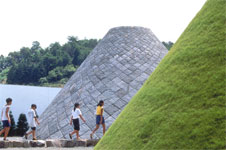 |
|||
|
PETER WALKER Landscape architect Peter Walker, cofounder of Sasaki, Walker, and Associates and Peter Walker and Partners, has been teaching and practicing for over forty years. With a wide breadth of experience and interests, Walker has completed projects around the world, ranging from small gardens to large cities and has collaborated with architects such as I.M. Pei, Rem Koolhaas, and Arata Isozaki, among others. Recent projects include Saitama Plaza and Harima Town Park in Japan, Sony Center and DIFA in Berlin, and Millennium Park 2000 Sydney Olympics. Walker and his firm are currently working on the World Trade Center Memorial with Michael Arad. For more information about Peter Walker Partners please visit www.pwpla.com. |
||||
|
||||
|
ELIAS TORRES TUR From open-air theaters to hillside escalators, Barcelona-based architect and landscape designer Elías Torres Tur finds creative responses to the need for urban public space. In Toledo, Torres and his partner José Antonio Martinez Lapeña tackled the city’s traffic difficulties by building a moving staircase into the hill, connecting a newly constructed parking garage with the historic quarter and serving as a new gate to the old city. An equally dazzling project for Barcelona’s revitalized waterfront involves a 113,000-square-foot solar collector providing energy for the waterfront’s 25-acre forum, also designed in part by Torres and Lapeña. |
||||
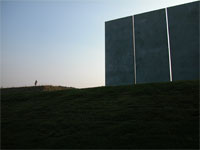 |
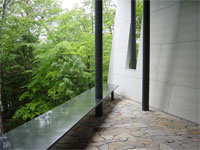 |
|||
|
15 YEARS OF COLLABORATION Collaboration is key for Mack Scogin and Merrill Elam: between the firm principals, between the architects and their clients; and between the architects and their collaborators. The firm’s designs respond forcefully and sympathetically to sites in such projects as the Mountain House, Dillard, Georgia; the Willow Street Residence Hall, Tulane University; ad the D. Abbott Turner Village at the Candler School of Theology, Emory University. Michael Van Valkenburgh founded Michael Van Valkenburgh Associates in 1982. Design Principal Matthew Urbanski joined the firm in 1989 and now heads the office in Cambridge, MA. For the past fifteen years, the two landscape architects have worked together on projects throughout the United States as well as internationally. The firm’s projects include institutional plans, corporate landscapes, civic spaces and parks, and residential work. They are currently working on a landscape design for Hudson River Park, Segment 5, and the Brooklyn Bridge Park Master Plan. Mack Scogin Merrill Elam Architects and Michael Van Valkenburgh Associates have joined forces on several projects in the last 15 years, including the Herman Miller Factory in Canton, Georgia, as well as various residential projects. Ongoing projects include the Wellesley College Campus and the Knowlton School of Architecture. For more information about Scogin Elam Architects, please visit www.msmearch.com; for information about Michael Van Valkenburgh Associates, visit www.mvvainc.com. |
||||
|
CHRISTO AND JEANNE-CLAUDE Oftentimes only by disrupting space are we able to see it in a new light. Since the late 1950s, the large-scale art installations of Christo and Jeanne-Claude have forced onlookers to constantly reevaluate their surrounding environment. Past projects include the wrapping of the Pont Neuf in Paris (1985) and the Reichstag in Berlin (1995) as well as a host of other projects in the U.S., Europe, Asia, and Australia. One of their current projects, The Gates, Project for Central Park, opened in February 2005 when 7500 saffron fabric panels were unfurled from gates 16 feet in height throughout 23 miles of the park. Christo and Jeanne-Claude pay for the expense of all their projects through the sale of original work; they accept no sponsors. For more information about the artists please visit their website www.christojeanneclaude.net. |
||||
|
||||
|
JOHN PATKAU Since founding Patkau Architects in 1978, Canadian architects John and Patricia Patkau have produced designs for a wide variety of building types that have been repeatedly recognized with national and international awards. Two houses designed by the firm – one set in a constrained site in the architects’ hometown of Vancouver, the other on a rural site in San Juan Island – won 2004 Governor General’s Medals in Architecture. Juror Markku Komomen cited the latter for its siting and architectural character, which create “a simple, solid body with many interior and exterior pockets for living and celebrating the landscape.” Current work includes student housing at the University of Pennsylvania, an ecological hotel in Beacon, NY, the new central Library in Montreal and an interdisciplinary Center for Music, Art and Design at the University of Manitoba. For further information about Patkau Architects please visit www.patkau.ca. |
||||
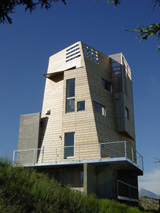 |
||||
|
CLARK STEVENS Clark Stevens heads the conservation-based projects at RoTo Architects in Los Angeles. He is also president of the New West Land Company, Inc., based in Livingston, Montana. The New West Land Company "promotes a new conservation methodology that uses place appropriate development" to guide conservation and restoration decisions in integrating "the human and biological communities." His current work includes a mapping project in the western United States exploring spatial characteristics that define a 'sense of place' to be utilized for community conservation-based land planning and design. |
||||
 |
||||
|
EYAL WEIZMAN Based in Tel Aviv and London, architect Eyal Weizman explores the political struggle on the West Bank through architecture, urban planning, research, and map-making. In 2003, Weizman and fellow Israeli architect Rafi Segal organized the exhibition A Civilian Occupation: The Politics of Israeli Architecture, shown at Storefront for Art and Architecture. Weizman has also designed maps of the West Bank for the human rights group B'tselem and co-authored the human rights report Land Grab in 2002. He is currently developing his doctoral thesis, The Politics of Verticality / Architecture and Occupation in the West Bank and Gaza, into a book and documentary film. |
||||
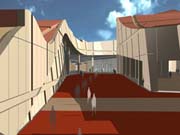 |
 |
|||
|
PETER EISENMAN, LAURIE OLIN Peter Eisenman and Laurie Olin will discuss their current project for a cultural complex in Santiago, Spain. The medieval town of Santiago de Compostela, in the Galicia region of Spain, is undergoing major transformations with the addition of a new cultural complex just two miles outside the heart of the city. The City of Culture of Galicia, intended to boost tourism to the area and to enrich the existing local culture, is situated on a landscaped "magic mountain" and includes two museums, two libraries, an opera house, and an administrative building. |
||||
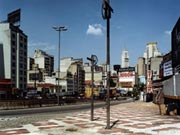 |
 |
|||
|
STEPHEN SHORE, THOMAS STRUTH Moderators: Mitch Epstein and Vicki Goldberg Stephen Shore's photographic series Uncommon Places explored the American vernacular landscape in the 1970s and early 1980s and became an influential body of work for many young photographers. In the 1990s, Shore began focusing on black and white photography and traveled abroad to photograph archaeological excavations and small villages in Israel and Italy. A common thread that loosely connects his work, according to the artist, is "the observation of culture." Shore became the first living photographer to have a one-man exhibition at the Metropolitan Museum of Art in 1971 and has since exhibited in many venues around the world. Photographer Thomas Struth's work ranges from American and European streetscapes to South American and Asian jungle landscapes to contemporary museum interiors, drawing on cultural conditions in various locales. Among Struth's recent exhibitions is a 2003 retrospective at the Metropolitan Museum of Art, during which the artist's large-scale video portraits were also projected on the walls of the Metropolitan Museum's Great Hall. |
||||
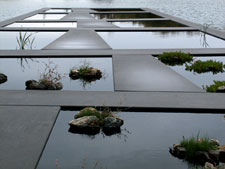 |
||||
|
GROUNDSWELL Keynote Address Symposium Participants included: James Corner, Director, Field Operations, New York and Chair and Professor of Landscape Architecture, University of Pennsylvania School of Design; Michel Desvigne, Paris, France; Kathryn Gustafson, Seattle, Washington and London, England; George Hargreaves, Hargreaves Associates, Cambridge, Massachusetts, New York, New York, and San Francisco, California; Martha Schwartz, Martha Schwartz, Inc., Cambridge, Massachusetts; Ken Smith, Ken Smith Landscape Architect, New York, New York; Marion Weiss and Michael Manfredi, Weiss/Manfredi Architects, New York, New York. For more information about projects included in the exhibition, visit the Museum of Modern Art’s website: http://www.moma.org/exhibitions/2005/groundswell.html. Events co-organized with The Museum of Modern Art. |
||||
|
JOEL STERNFELD, SALLY MANN Moderators Mitch Epstein and Vicki Goldberg New York-born photographer Joel Sternfeld uses photography to explore the meaning of place and site by observing and capturing the everyday landscape. Among his published works are American Prospects, On This Site, Stranger Passing, and Walking the High Line. Sternfeld is the recipient of two Guggenheim fellowships and a Prix de Rome. He has exhibited at the Museum of Modern Art, the Art Institute of Chicago, the Museum of Fine Arts in Houston, and the Fotomuseum in Winterhur, Switzerland. Though most well-known for her portraits, Virginia-born Sally Mann also photographs large-scale landscapes in the rural South. Whether they are photographs of her three children playing in the backyard or of vast sprawling views of the Shenandoah Valley, an overwhelming sense of place is inherent in Mann's work. Mann is a recipient of numerous awards including three National Endowment for the Arts grants and a Guggenheim fellowship, and her photographs are in the collections of the Metropolitan Museum of Art, the Museum of Modern Art, the Whitney Museum of American Art, and the Museum of Fine Arts, Boston. |
||||
 |
 |
|||
|
ELIZABETH DILLER In their broadly based interdisciplinary practice, Diller Scofidio + Renfro fuse architecture, the visual arts and the performing arts. The firm's work takes the form of architectural commissions, site-specific installations, multi-media theater, electronic media and print. Elizabeth Diller and Ricardo Scofidio, the firm's founding partners, were the first architects to receive a MacArthur Foundation Award. Current and recent projects include the Blur Building for the Swiss Expo 2002, Facsimile, a permanent media installation for the Moscone Convention Center West in San Francisco, an expansion and renovation of facilities and public spaces for Lincoln Center, the ICA, Boston, and the conversion of Manhattan's High Line in to an elevated public greenspace. |
||||
THE FIRST ANNUAL ELEANORE PETTERSEN LECTURE The Annual Eleanore Pettersen Lecture was established in honor of Cooper Union alumna Eleanore Pettersen through a generous donation to The Irwin S. Chanin School of Architecture. The lectures, dedicated to the voices of women in architecture, will be a lasting tribute to Ms. Pettersen, her significant impact in the world of architecture, and her love of The Cooper Union. Eleanore Pettersen attended evening courses at The Cooper Union, completing her studies in 1941. Shortly thereafter, she applied for an apprenticeship with Frank Lloyd Wright at Taliesin West and was the only woman among a group of approximately fifty who were accepted. In 1952, Ms. Pettersen opened her own architectural practice in Northern New Jersey. She was one of the first women to be licensed as an architect in that state, where she developed a highly successful practice that spanned over fifty years.  TOSHIKO MORI Toshiko Mori established her firm, Toshiko Mori Architect, in New York City in 1981. With a background in fine arts, Mori has a unique conceptual and aesthetic approach to each project, complemented by her research-based process to design. Since 1983, she has taught at Cooper Union and now, Harvard University Graduate School of Design, where she has been tenured since 1995 and Department Chair since 2002. She has edited one volume on material and fabrication research, Immaterial/Ultramaterial, which points to a recent direction and interest with materiality in architecture, and one on the use of weaving in low- and high-tech applications, Textile Tectonic. Toshiko Mori's intelligent approach to historical context, siting strategy and the use of materials reflects creative integration of design and technology. Each project involves extensive studies in the historical precedence, site and programmatic conditions, in order to provide an architecture that responds dialectically and appropriately. Rooted firmly in the tradition of modernistic design vocabulary, her ethical design approach calls for economy of means and efficiency of structure, giving fresh direction for the continuity of the modernist legacy. |
||||

